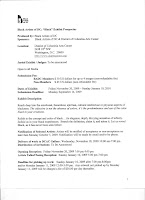
Don Griffin, Baltimore artist with Washington, DC roots, has been notified that his work, "Port Arthur," was selected for inclusion in the upcoming Rauschenberg Tribute Exhibition. The exhibition will be on view in the Dunn Gallery at the Museum of the Gulf Coast in Port Arthur, Texas from August 30, 2009 to October 22, 2009.Please View Announcement at Link Below :http://www.comzee.com/RauschenbergTributeDonGriffinAnnouncement.html
In a discussion, with Don regarding the competition, I posed two questions to him. What was your intent as you prepared the piece for competition? Share with me any feelings or words about the piece and/or the competition.
Don's responses follow: "When I first heard that Rauschenberg had passed, I was very sorry to hear it. He was probably my favorite artist. I believe I own 3 books on him. In the 1990's I was working on assemblages from time to time when I wasn't painting. There was a need for works in 2D & 3D that compelled me to seek a solution where in I could do both disciplines. I was moving out of my soft sculpture period, which was my primary method for making statements in art.
During this period, I was represented by HENRI GALLERY in Washington, DC. Henri had an Avant Garde stable of artists, and they worked in the sculpture field. I didn't realize at the time I was also creating sculpture, until she enlightened me! When she passed in 1996, I was left to start all over again in the search of new representation. This also was a turning point leading out of soft sculpture exclusively. About this time, I began working with assemblages in wood. Not too long afterwards, I began incorporating elements of soft sculpture with the assemblages.
One day I visited a Book Store in Towson, Maryland to browse though the art books section. I came across a book on Rauschenberg, whom I had not been aware of, and discovered he was working in a similar manner, which he described as combines. I was totally in shock! I skimmed through the book for a while and left. The book was like haunting me to go back and purchase it. The $75 price tag was the evil that kept me from going back. I later lost the fight, and purchased my first $75 Art Book! Ever since that time, I have been a fan.
When hearing about the loss of Rauschenberg, I almost immediately began thinking about creating a piece in homage to him. Nothing was evident at the time, so it slipped in the recess of my mind. Then one day as I looked at art calls, I discovered a competition that was being organized by the Gulf Coast Museum in Port Arthur, Texas. I told my friend Diana about it, and how I would like to be a participant. I mean, how could I not be included in this exhibition? I told her. This is my arena, this is what I do. Its the perfect time to create that piece that I consider reflective of the artist I admired so much.
I determined after some time that the piece would contain card board as an element in the piece. This size gave me a problem, because I wanted it to be larger than the criteria dictated. Later, I put the size issue behind me and stretched a 37"x 48" canvas. Diana assisted me in locating a collection of boxes from various sources for the composition which was developing.
Elements were being collected which I considered connective to Rauschenberg. He thought a lot of the newspaper. So, there would be evidence of it somewhere in the composition. I settled on a hot topic at the time...The Automakers. Then there was the Presidential Photo Strip I created with the First Black President, some controversials such as Bill Clinton, Richard Nixon, Bush Jr, etc. A reverse positive photo of Rauschenberg with a bicycle, and a reverse positive of a cow. It has always intrigued me the way farm animals reacted when approached. In unison, they all stop and turn their heads to look at you...like what's up?
The card board element had a real need to be in Port Arthur. Many various type boxes were collected for this purpose, and I think the one that most said Rauschenberg for me...was the kid. I wanted the top layer of the card board and it was not particularly easy to separate it from the corrugated section. It was a very physical struggle to do it, especially for the hands and the effects of discomfort traveled to my back."
I appreciate that Don agreed to allow me to share his experience with you.




